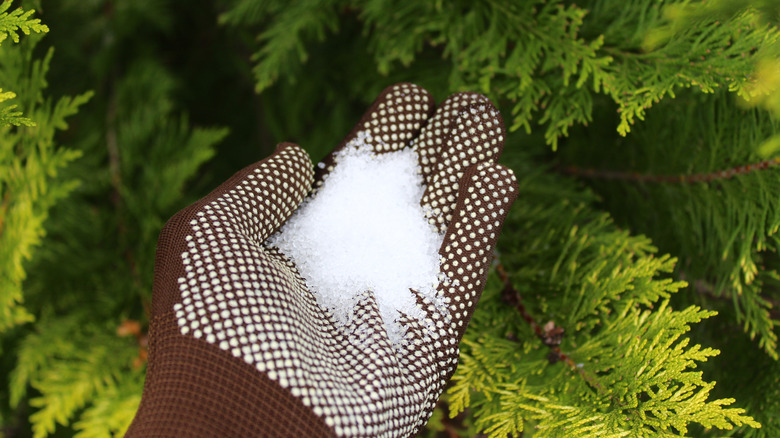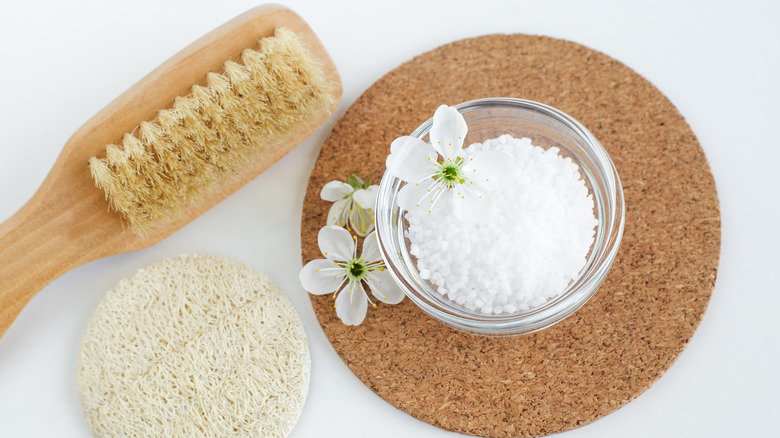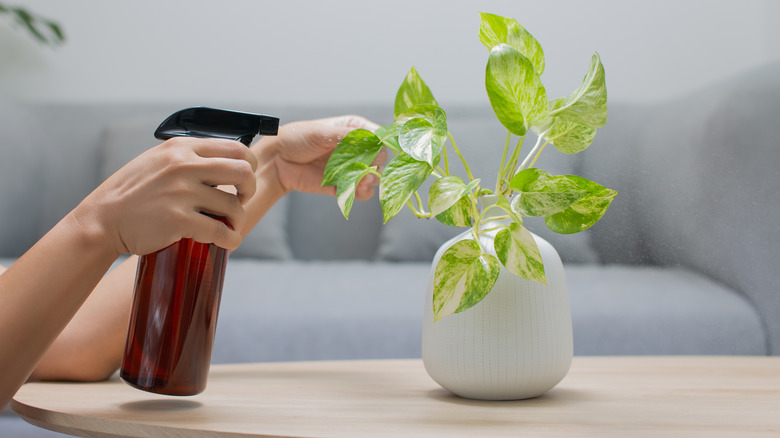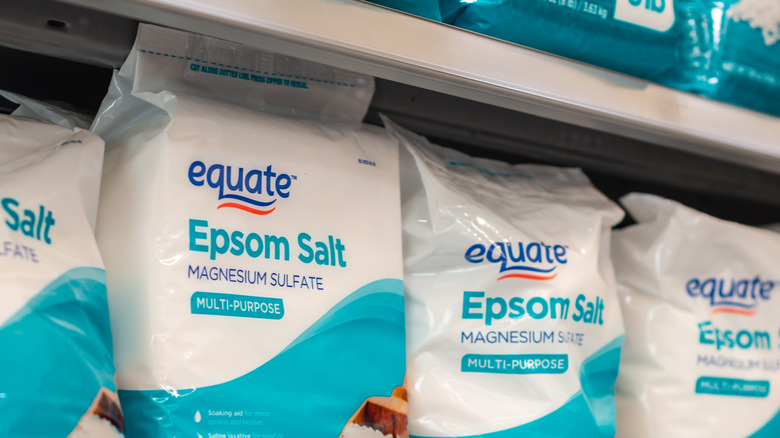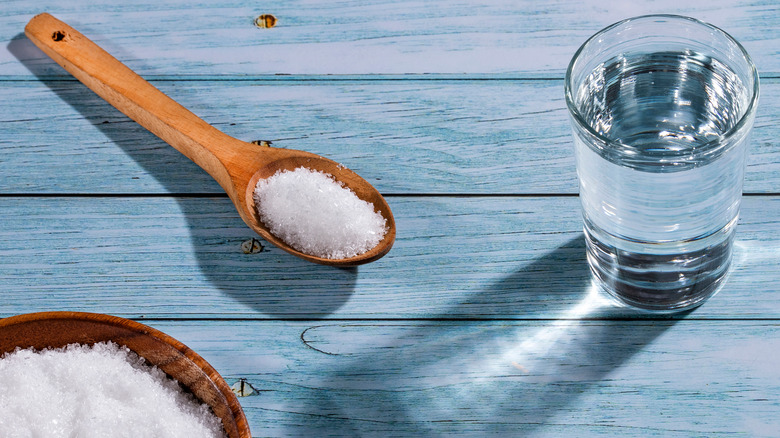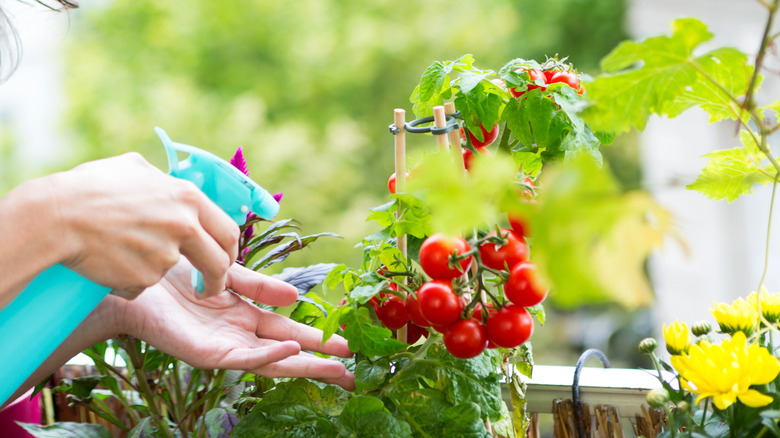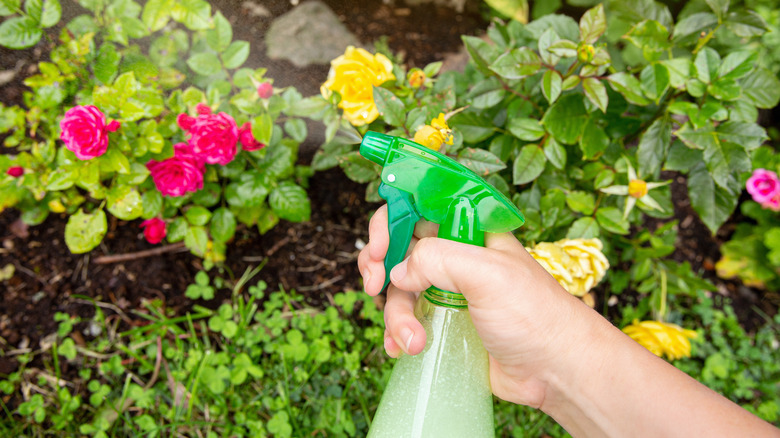What Is Epsom Salt And What Does It Do For Your Garden?
We may receive a commission on purchases made from links.
If you are looking for new ways to take care of your leafy babies, we might have one idea for you: Epsom salt. Also known as magnesium sulfate, Epsom salt is a chemical compound composed of magnesium, sulfur, and oxygen. Many gardeners and plant experts have recommended using this natural mineral on different plants to help improve many things, including growth and the color of flowers.
You might already be familiar with Epsom salt as it's famously employed when drawing baths. If not, you've probably heard that it can reduce aches, pain, muscle soreness, swelling, and other ailments, via Healthline. But that's a discussion for another time.
According to Gardening Know How, the use of Epsom salt on plants is not new and has been around for generations. For years, avid gardeners have passed down the knowledge surrounding the benefits of Epsom salt. This inexpensive alternative to commercial fertilizers is safe to try on almost any plant.
The history of Epsom salt
Named after the city of Epsom in England, Epsom salt was discovered in the early 17th century when it first started bubbling in the water of an underground spring. Epsom soon became a spa hub when word of its valued commodity got out; it was even one of the first in the country. Many traveled to the town to experience the benefits of the mineral, and Epsom soon became recognized for it. However, according to Apartment Therapy, the town's wells soon dried up, and salt mining became nearly impossible, causing people to lose interest in the once bustling borough. Today, people remember the historic town for its contribution to the world.
People first used Epsom salt for its laxative effect due to the natural purging effects of the water and to help relieve the painful symptoms of gout. Soon it was recognized for different reasons, namely its beauty applications, via Prevention. Today, Epsom salt has not only beauty benefits but is also used in gardening, health, crafting, and cleaning. In the United States, the two biggest producers of Epsom salt are Giles and PQ Corporation.
Epsom salt for plant care
There are many reasons you should start using Epsom salt on your plants. Firstly, it contains magnesium, so it is ideal for your leafy babies, especially if they lack this vital nutrient. Performing a soil test will let you know if that's the case. Do keep in mind that soil tests are essential regardless of whether you are thinking of using Epsom salt. It is one of the ways to indicate if your plant is healthy and has enough of the proper nutrients.
Visually, you can tell if your plant could use some Epsom salt. According to mindbodygreen, interveinal chlorosis, which manifests in splotchy yellowing between leaf veins, indicates low magnesium levels.
If you have a bug-infested plant, Epsom salt will also help eliminate them. Lastly, for new plants, you can add this mineral to the planting hole directly to help the plant get all the proper nutrients and color from the start.
What are the benefits?
There are multiple benefits to using Epsom salt on your plants, both visually and for their overall well-being, the most significant being to promote growth. If your plant is having difficulty reaching its full capacity, Epsom salt might be the TLC it needs!
When repotting your plant, you might want to use a little Epsom salt to help prevent transplant shock, which is common when moving a plant into a new pot, says Plant Care Today. Epsom salt can also protect your plants from bugs and diseases, informs Gardening Know How, since they are susceptible to viruses, bacteria, and much more. High magnesium levels might have something to do with it.
Furthermore, Epsom salt has also proven to boost photosynthesis, germination, and seed formation, helping to strengthen cell walls and leading to vigorous seedlings. It is also very commonly known to improve the flavor of plants that produce fruits and vegetables. According to Masterclass, the mineral helps produce chlorophyll, which contains sugar, and the more sugar it has, the sweeter and more flavorful the fruits and vegetables will be.
Finally, a visual benefit of Epsom salt is its capacity to help flowering plants produce more flowers. It will also help you grow greener and just overall prettier plants, via Gardening Know How.
What are the dangers?
Some gardeners are wary of Epsom salt for plants despite its incredible benefits. As pointed out by Morning Chores, it is not infallible because, as a mineral, it can quickly become a contaminant. That's right, an excess amount of magnesium added to your plant can contaminate nearby water supplies. If applied directly to leaves, Epsom salt can also cause leaf burn.
The essential thing to remember is that you should use moderately and only apply to soil deficient in magnesium; skipping this step could be detrimental to your plants. Many gardeners claim that the use of Epsom salt today on plants is primarily due to tradition and not so much its benefits, while others say it has done wonders for them. The risks to this salt are minimal compared to its payoff, and it can be an inexpensive but effective way to take care of your leafy babies.
What are the best plants to use Epsom salt on?
Generally, any magnesium-deficient plant will benefit from Epsom salt, but three are most talked about.
The first is the pepper plant, per Balcony Garden Web. The combination of magnesium and sulfur in Epsom salt speeds up growth, increases water retention, and makes them tastier overall. The rose is one of the flowers that bloom incredibly well if you add some Epsom salt. In most cases, roses can thrive on their own, but adding Epsom salt to the planting hole might give them that extra boost they need to be fuller, greener, and all-around prettier. Apply to the soil directly as contact with the leaves could damage them. Finally, tomato plants are also known to do better after Epsom salt use, yielding tastier and sweeter produce (via SFGate.)
Use a moderate amount of Epsom salt in the soil, as the magnesium could interfere with calcium uptake and create an imbalance in your plant. However, if used right, you will harvest better produce at the end of the planting season.
How to apply Epsom salt to your plants
There are different ways to apply Epsom salt, but the type of plant can also determine the techniques.
Gardening Know How says you can replace regular watering with Epsom salt watering. In this case, you can dilute 2 tablespoons of Epsom salt per gallon of water and apply it in a foliar spray. However, bring that down to 1 tablespoon if you water more than once or twice a month — tomatoes and peppers can withstand twice a month watering, though.
For roses, apply ½ a cup of Epsom salt straight to the soil and around the bush's base at the beginning of the blooming season, then spray occasionally. This Old House advises applying 1 tablespoon of Epsom salt to the soil of shrubs like azaleas and rhododendrons every two to four weeks.
For green lawn or to encourage seed germination, you can sprinkle some Epsom salt directly into the soil at the onset or spray if the growth has already begun.
